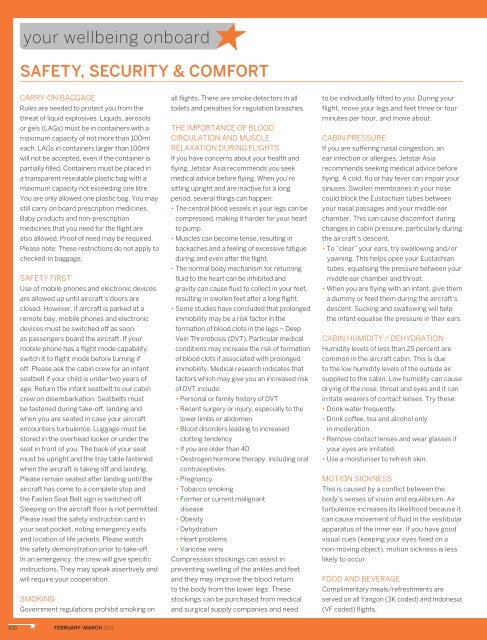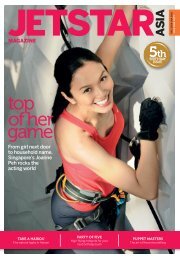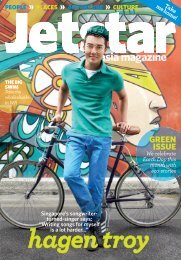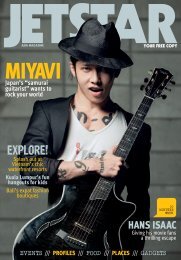You also want an ePaper? Increase the reach of your titles
YUMPU automatically turns print PDFs into web optimized ePapers that Google loves.
your wellbeing onboard<br />
SAFETY, SECURITY & COMFORT<br />
CARRY-ON BAGGAGE<br />
Rules are needed to protect you from the<br />
threat of liquid explosives. Liquids, aerosols<br />
or gels (LAGs) must be in containers with a<br />
maximum capacity of not more than 100ml<br />
each. LAGs in containers larger than 100ml<br />
will not be accepted, even if the container is<br />
partially filled. Containers must be placed in<br />
a transparent resealable plastic bag with a<br />
maximum capacity not exceeding one litre.<br />
You are only allowed one plastic bag. You may<br />
still carry on board prescription medicines.<br />
Baby products and non-prescription<br />
medicines that you need for the flight are<br />
also allowed. Proof of need may be required.<br />
Please note: These restrictions do not apply to<br />
checked-in baggage.<br />
SAFETY FIRST<br />
Use of mobile phones and electronic devices<br />
are allowed up until aircraft’s doors are<br />
closed. However, if aircraft is parked at a<br />
remote bay, mobile phones and electronic<br />
devices must be switched off as soon<br />
as passengers board the aircraft. If your<br />
mobile phone has a flight mode capability,<br />
switch it to flight mode before turning if<br />
off. Please ask the cabin crew for an infant<br />
seatbelt if your child is under two years of<br />
age. Return the infant seatbelt to our cabin<br />
crew on disembarkation. Seatbelts must<br />
be fastened during take-off, landing and<br />
when you are seated in case your aircraft<br />
encounters turbulence. Luggage must be<br />
stored in the overhead locker or under the<br />
seat in front of you. The back of your seat<br />
must be upright and the tray table fastened<br />
when the aircraft is taking off and landing.<br />
Please remain seated after landing until the<br />
aircraft has come to a complete stop and<br />
the Fasten Seat Belt sign is switched off.<br />
Sleeping on the aircraft floor is not permitted.<br />
Please read the safety instruction card in<br />
your seat pocket, noting emergency exits<br />
and location of life jackets. Please watch<br />
the safety demonstration prior to take-off.<br />
In an emergency, the crew will give specific<br />
instructions. They may speak assertively and<br />
will require your cooperation.<br />
SMOKING<br />
Government regulations prohibit smoking on<br />
100 FEBRUARY/MARCH <strong>2011</strong><br />
all flights. There are smoke detectors in all<br />
toilets and penalties for regulation breaches.<br />
THE IMPORTANCE OF BLOOD<br />
CIRCULATION AND MUSCLE<br />
RELAXATION DURING FLIGHTS<br />
If you have concerns about your health and<br />
flying, Jetstar Asia recommends you seek<br />
medical advice before flying. When you’re<br />
sitting upright and are inactive for a long<br />
period, several things can happen:<br />
• The central blood vessels in your legs can be<br />
compressed, making it harder for your heart<br />
to pump.<br />
• Muscles can become tense, resulting in<br />
backaches and a feeling of excessive fatigue<br />
during and even after the flight.<br />
• The normal body mechanism for returning<br />
fluid to the heart can be inhibited and<br />
gravity can cause fluid to collect in your feet,<br />
resulting in swollen feet after a long flight.<br />
• Some studies have concluded that prolonged<br />
immobility may be a risk factor in the<br />
formation of blood clots in the legs – Deep<br />
Vein Thrombosis (DVT). Particular medical<br />
conditions may increase the risk of formation<br />
of blood clots if associated with prolonged<br />
immobility. Medical research indicates that<br />
factors which may give you an increased risk<br />
of DVT include:<br />
• Personal or family history of DVT<br />
• Recent surgery or injury, especially to the<br />
lower limbs or abdomen<br />
• Blood disorders leading to increased<br />
clotting tendency<br />
• If you are older than 40<br />
• Oestrogen hormone therapy, including oral<br />
contraceptives<br />
• Pregnancy<br />
• Tobacco smoking<br />
• Former or current malignant<br />
disease<br />
• Obesity<br />
• Dehydration<br />
• Heart problems<br />
• Varicose veins<br />
Compression stockings can assist in<br />
preventing swelling of the ankles and feet<br />
and they may improve the blood return<br />
to the body from the lower legs. These<br />
stockings can be purchased from medical<br />
and surgical supply companies and need<br />
to be individually fitted to you. During your<br />
flight, move your legs and feet three or four<br />
minutes per hour, and move about.<br />
CABIN PRESSURE<br />
If you are suffering nasal congestion, an<br />
ear infection or allergies, Jetstar Asia<br />
recommends seeking medical advice before<br />
flying. A cold, flu or hay fever can impair your<br />
sinuses. Swollen membranes in your nose<br />
could block the Eustachian tubes between<br />
your nasal passages and your middle ear<br />
chamber. This can cause discomfort during<br />
changes in cabin pressure, particularly during<br />
the aircraft’s descent.<br />
• To “clear” your ears, try swallowing and/or<br />
yawning. This helps open your Eustachian<br />
tubes, equalising the pressure between your<br />
middle ear chamber and throat.<br />
• When you are flying with an infant, give them<br />
a dummy or feed them during the aircraft’s<br />
descent. Sucking and swallowing will help<br />
the infant equalise the pressure in their ears.<br />
CABIN HUMIDITY / DEHYDRATION<br />
Humidity levels of less than 25 percent are<br />
common in the aircraft cabin. This is due<br />
to the low humidity levels of the outside air<br />
supplied to the cabin. Low humidity can cause<br />
drying of the nose, throat and eyes and it can<br />
irritate wearers of contact lenses. Try these:<br />
• Drink water frequently.<br />
• Drink coffee, tea and alcohol only<br />
in moderation.<br />
• Remove contact lenses and wear glasses if<br />
your eyes are irritated.<br />
• Use a moisturiser to refresh skin.<br />
MOTION SICKNESS<br />
This is caused by a conflict between the<br />
body’s senses of vision and equilibrium. Air<br />
turbulence increases its likelihood because it<br />
can cause movement of fluid in the vestibular<br />
apparatus of the inner ear. If you have good<br />
visual cues (keeping your eyes fixed on a<br />
non-moving object), motion sickness is less<br />
likely to occur.<br />
FOOD AND BEVERAGE<br />
Complimentary meals/refreshments are<br />
served on all Yangon (3K coded) and Indonesia<br />
(VF coded) flights.
















